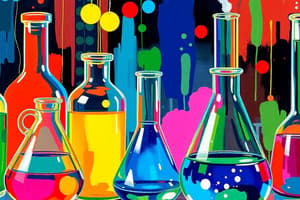Podcast
Questions and Answers
What is the role of sodium carbonate in the extraction of caffeine?
What is the role of sodium carbonate in the extraction of caffeine?
- React with tannin and gallic acid to form products soluble in dichloromethane (correct)
- React with benzoic acid to form a solid precipitate
- React with caffeine to facilitate extraction
- React with water to remove impurities
What is the purpose of anhydrous sodium sulfate in the extraction process?
What is the purpose of anhydrous sodium sulfate in the extraction process?
- Remove water from the organic layer (correct)
- React with caffeine to form a soluble compound
- React with impurities to make them volatile
- Enhance the solubility of benzoic acid
What is sublimation as described in the text?
What is sublimation as described in the text?
- Transition of a solid into a gas without passing through the liquid stage (correct)
- Transition of a gas into a solid
- Transition of a liquid into a gas
- Transition of a solid into a liquid
Which type of impurity makes substances suitable for purification by sublimation?
Which type of impurity makes substances suitable for purification by sublimation?
At what temperature does benzoic acid change from a solid to a liquid?
At what temperature does benzoic acid change from a solid to a liquid?
What distinguishes pure substances from impure substances in terms of melting points?
What distinguishes pure substances from impure substances in terms of melting points?
Why is benzoic acid commonly used as a food preservative?
Why is benzoic acid commonly used as a food preservative?
What distinguishes substances suitable for sublimation purification?
What distinguishes substances suitable for sublimation purification?
Which process involves the conversion of a solid directly into a gas?
Which process involves the conversion of a solid directly into a gas?
Flashcards are hidden until you start studying




